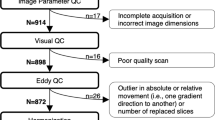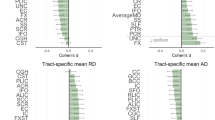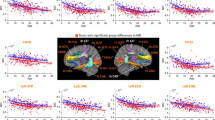Abstract
There is controversy regarding specificity of white matter abnormalities in psychosis, their deviation from healthy aging, and the influence of sex on these measures. We used diffusion tensor imaging to characterize putative white matter microstructure in 224 patients with psychosis and healthy volunteers across the age range of 15–64 years. Sixty-five younger (age <30 years; 47M/18F) patients with psychosis (all experiencing a first episode of illness) and 48 older (age ⩾30 years; 30M/18F) patients were age-matched to younger and older healthy volunteer groups (N=63 (40M/23F) and N=48 (29M/19F), respectively). The trajectories of two inter-hemispheric (splenium and genu), two projection (cortico-pontine and anterior thalamic), and five bilateral association (inferior fronto-occipital, inferior longitudinal, superior longitudinal, cingulum, and uncinate) tracts were quantified using tractography to derive measures of fractional anisotropy and mean, axial, and radial diffusivity. Fractional anisotropy was significantly lower in the inferior longitudinal fasciculus and superior longitudinal fasciculus in all patients compared with all healthy volunteers, with comparable effect sizes observed in both the younger and older patients compared with their respective healthy volunteer groups. Moreover, age-associated differences in fractional anisotropy within these tracts were comparable between groups across the age span. In addition, female patients had significantly lower fractional anisotropy across all tracts compared with female controls regardless of age. Our findings demonstrate comparable putative white matter abnormalities in two independent samples of patients with psychosis and argue against their progression in patients. These data further highlight the novel and potentially underappreciated role of sex in understanding white matter dysfunction in the neurobiology of psychosis.
Similar content being viewed by others
Log in or create a free account to read this content
Gain free access to this article, as well as selected content from this journal and more on nature.com
or
References
Abel KM, Drake R, Goldstein JM (2010). Sex differences in schizophrenia. Int Rev Psychiatry 22: 417–428.
Behrens TEJ, Woolrich MW, Jenkinson M, Johansen‐Berg H, Nunes RG, Clare S et al (2003). Characterization and propagation of uncertainty in diffusion‐weighted MR imaging. Mag Reson Med 50: 1077–1088.
Buchsbaum MS, Tang CY, Peled S, Gudbjartsson H, Lu D, Hazlett EA et al (1998). MRI white matter diffusion anisotropy and PET metabolic rate in schizophrenia. Neuroreport 9: 425–430.
Chanraud S, Zahr N, Sullivan EV, Pfefferbaum A (2010). MR diffusion tensor imaging: a window into white matter integrity of the working brain. Neuropsychol Rev 20: 209–225.
Cheung V, Cheung C, McAlonan GM, Deng Y, Wong JG, Yip L et al (2008). A diffusion tensor imaging study of structural dysconnectivity in never-medicated, first-episode schizophrenia. Psychol Med 38: 877–886.
Ćurčić-Blake B, Nanetti L, van der Meer L, Cerliani L, Renken R, Pijnenborg GH et al (2015). Not on speaking terms: hallucinations and structural network disconnectivity in schizophrenia. Brain Struct Funct 220: 1–12.
Ellison-Wright I, Bullmore E (2009). Meta-analysis of diffusion tensor imaging studies in schizophrenia. Schizophr Res 108: 3–10.
Epstein KA, Cullen KR, Mueller BA, Robinson P, Lee S, Kumra S (2014). White matter abnormalities and cognitive impairment in early-onset schizophrenia-spectrum disorders. J Am Acad Child Adolesc Psychiatry 53: 362–372.
Fitzsimmons J, Kubicki M, Shenton ME (2013). Review of functional and anatomical brain connectivity findings in schizophrenia. Curr Opin Psychiatry 26: 172–187.
Friedman J, Tang C, Carpenter D, Buchsbaum M, Schmeidler J, Flanagan L et al (2008). Diffusion tensor imaging findings in first-episode and chronic schizophrenia patients. Am J Psychiatry 165: 1024–1032.
Gogos A, Kwek P, van den Buuse M (2012). The role of estrogen and testosterone in female rats in behavioral models of relevance to schizophrenia. Psychopharmacology 219: 213–224.
Goldstein JM, Cherkerzian S, Tsuang MT, Petryshen TL (2013). Sex differences in the genetic risk for schizophrenia: history of the evidence for sex-specific and sex-dependent effects. Am J Med Genet B Neuropsychiatr Genet 162B: 698–710.
Jenkinson M, Beckmann CF, Behrens TE, Woolrich MW, Smith SM (2012). FSL. Neuroimage 62: 782–790.
Karlsgodt KH, Sanz J, van Erp TG, Bearden CE, Nuechterlein KH, Cannon TD (2009). Re-evaluating dorsolateral prefrontal cortex activation during working memory in schizophrenia. Schizophr Res 108: 143.
Karlsgodt KH, van Erp TG, Poldrack RA, Bearden CE, Nuechterlein KH, Cannon TD (2008). Diffusion tensor imaging of the superior longitudinal fasciculus and working memory in recent-onset schizophrenia. Biol Psychiatry 63: 512–518.
Kochunov P, Glahn DC, Rowland LM, Olvera RL, Winkler A, Yang YH et al (2013). Testing the hypothesis of accelerated cerebral white matter aging in schizophrenia and major depression. Biol Psychiatry 73: 482–491.
Kubicki M, Khan U, Westin CF, Pieper S, McCarley R, Shenton M (2008). Atlas-based white matter segmentation of DTI in schizophrenia. Schizophr Res 102: 82.
Kunimatsu N, Aoki S, Kunimatsu A, Abe O, Yamada H, Masutani Y et al (2012). Tract-specific analysis of white matter integrity disruption in schizophrenia. Psychiatry Res 201: 136–143.
Lei W, Li M, Deng W, Zhou Y, Ma X, Wang Q et al (2015). Sex-specific patterns of aberrant brain function in first-episode treatment-naïve patients with schizophrenia. Int J Mol Sci 16: 16125–16143.
Lener MS, Wong E, Tang CY, Byne W, Goldstein KE, Blair NJ et al (2015). White matter abnormalities in schizophrenia and schizotypal personality disorder. Schizophr Bull 41: 300–310.
Lim KO, Hedehus M, Moseley M, de Crespigny A, Sullivan EV, Pfefferbaum A (1999). Compromised white matter tract integrity in schizophrenia inferred from diffusion tensor imaging. Arch Gen Psychiatry 56: 367–374.
Peters BD, Karlsgodt KH (2014). White matter development in the early stages of psychosis. Schizophr Res 161: 61–69.
Peters BD, Ikuta T, DeRosse P, John M, Burdick KE, Gruner P et al (2014). Age-related differences in white matter tract microstructure are associated with cognitive performance from childhood to adulthood. Biol Psychiatry 75: 248–256.
Rosenberger G, Kubicki M, Nestor PG, Connor E, Bushell GB, Markant D et al (2008). Age-related deficits in fronto-temporal connections in schizophrenia: a diffusion tensor imaging study. Schizophr Res 102: 181–188.
Savadjiev P, Whitford TJ, Hough ME, Clemm von Hohenberg C, Bouix S, Westin CF et al (2014). Sexually dimorphic white matter geometry abnormalities in adolescent onset schizophrenia. Cereb Cortex. 24: 1389–1396.
Sarubbo S, De Benedictis A, Merler S, Mandonnet E, Balbi S, Granieri E et al (2015). Towards a functional atlas of human white matter. Hum Brain Mapp 36: 3117–3136.
Samartzis L, Dima D, Fusar-Poli P, Kyriakopoulos M (2014). White matter alterations in early stages of schizophrenia: a systematic review of diffusion tensor imaging studies. J Neuroimaging 24: 101–110.
Schneiderman JS, Hazlett EA, Chu KW, Zhang J, Goodman CR, Newmark RE et al (2011). Brodmann area analysis of white matter anisotropy and age in schizophrenia. Schizophr Res 130: 57–67.
Szeszko PR, Strous RD, Goldman RS, Ashtari M, Knuth KH, Lieberman JA et al (2002). Neuropsychological correlates of hippocampal volumes in patients experiencing a first episode of schizophrenia. Am J Psychiatry 159: 217–226.
Szeszko PR, Ardekani BA, Ashtari M, Kumra S, Robinson DG, Sevy S et al (2005). White matter abnormalities in first-episode schizophrenia or schizoaffective disorder: a diffusion tensor imaging study. Am J Psychiatry 162: 602–605.
Szeszko PR, Robinson DG, Ikuta T, Peters BD, Gallego JA, Kane J et al (2014). White matter changes associated with antipsychotic treatment in first-episode psychosis. Neuropsychopharmacology 39: 1324–1331.
Paus T, Toro R (2009). Could sex differences in white matter be explained by g ratio? Front Neuroanat 3: 14.
Trzesniak C, Kempton MJ, Busatto GF, de Oliveira IR, Galvão-de Almeida A, Kambeitz J et al (2011). Adhesio interthalamica alterations in schizophrenia spectrum disorders: a systematic review and meta-analysis. Prog Neuropsychopharmacol Biol Psychiatry 35: 877–886.
Tseng BY, Gundapuneedi T, Khan MA, Diaz-Arrastia R, Levine BD, Lu H et al (2013). White matter integrity in physically fit older adults. Neuroimage 82: 510–516.
Voineskos AN, Foussias G, Lerch J, Felsky D, Remington G, Rajji TK et al (2013). Neuroimaging evidence for the deficit subtype of schizophrenia. JAMA Psychiatry 70: 472–480.
Voineskos AN, Lobaugh NJ, Bouix S, Rajji TK, Miranda D, Kennedy JL et al (2010). Diffusion tensor tractography findings in schizophrenia across the adult lifespan. Brain 133: 1494–1504.
Whalley HC, Sprooten E, Hackett S, Hall L, Blackwood DH, Glahn DC et al (2013). Polygenic risk and white matter integrity in individuals at high risk of mood disorder. Biol Psychiatry 74: 280–286.
White T, Magnotta VA, Bockholt HJ, Williams S, Wallace S, Ehrlich S et al (2011). Global white matter abnormalities in schizophrenia: a multisite diffusion tensor imaging study. Schizophr Bull 37: 222–232.
White T, Nelson M, Lim KO (2008). Diffusion tensor imaging in psychiatric disorders. Top Magn Reson Imaging 19: 97–109.
Wright SN, Kochunov P, Chiappelli J, McMahon RP, Muellerklein F, Wijtenburg SA et al (2014). Accelerated white matter aging in schizophrenia: role of white matter blood perfusion. Neurobiol Aging 35: 2411–2418.
Wu YC, Hill RA, Gogos A, Van Den Buuse M (2013). Sex differences and the role of estrogen in animal models of schizophrenia: interaction with BDNF. Neuroscience 239: 67–83.
Yao L, Lui S, Liao Y, Du MY, Hu N, Thomas JA et al (2013). White matter deficits in first episode schizophrenia: an activation likelihood estimation meta-analysis. Prog Neuropsychopharmacol Biol Psychiatry 45: 100–106.
Acknowledgements
We thank the individuals who participated in this study and Michelle Bergman and Jamie Wagner for study coordination.
Author information
Authors and Affiliations
Corresponding author
Rights and permissions
About this article
Cite this article
Schwehm, A., Robinson, D., Gallego, J. et al. Age and Sex Effects on White Matter Tracts in Psychosis from Adolescence through Middle Adulthood. Neuropsychopharmacol 41, 2473–2480 (2016). https://doi.org/10.1038/npp.2016.47
Received:
Revised:
Accepted:
Published:
Issue date:
DOI: https://doi.org/10.1038/npp.2016.47



